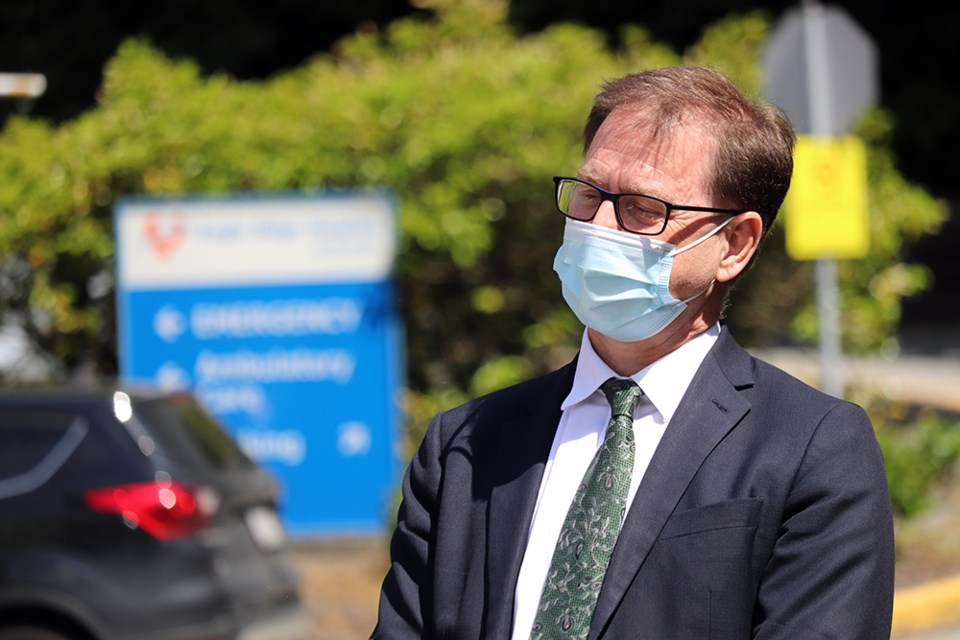Advocates of the public health-care system in B.C. say a steady rise in contracted surgeries to the private sector threatens to exacerbate workforce shortages in hospitals while providing questionable long-term benefits.
Health policy researcher Andrew Longhurst, with the Canadian Centre for Policy Alternatives and BC Health Coalition, says B.C. health authority contracts for public-funded medical procedures with for-profit surgical and diagnostic imaging clinics have increased 57% between 2016 and 2021, rising from $47.8 million to $75.4 million, respectively.
The growth has been most pronounced in contracted surgeries, rising from about $5 million in 2016 to about $28 million in 2021, according to Longhurst’s report titled “The concerning rise of corporate medicine.”
The contracts are intended to clear wait times by allowing public-funded procedures (typically non-urgent ones such as for orthopedics, cataracts or hernia repairs) to take place in private clinics; however, it appears health authorities are becoming more reliant on them, said Longhurst.
At issue, he says, is private clinics pulling staff away from hospitals — this at a time the Ministry of Health is experiencing emergency room closures across the province.
“The main issue right now,” said Longhurst, “is one of health human resources.”
The economies of scale hospitals can provide are being diminished, not improved, with such increased reliance on private facilities, argued Longhurst.
“We do have dual-delivery systems and the private sector is trying to out-compete for staff; you are pulling those limited pool of specialized health-care professionals out of the public system into the private delivery system. And that couldn't be happening at a worse time in B.C.,” said Longhurst.
“It makes it difficult to schedule full slates in our public [operating rooms], if you have staff that are increasingly working in private facilities where they may be paid a higher hourly wage,” Longhurst, a PhD candidate in the geography department at Simon Fraser University, told Glacier Media..
Additionally, “we know that the costs associated with outsourcing tend to be higher for a number of reasons, one of which is the profit margin that's built in. And then on top of that, we have evidence that suggests that outcomes are poorer as a result, because if you're profit-motivated, you are finding ways to cut costs on your most expensive operating expenses,” argued Longhurst.
In his report, Longhurst also raises questions over the provincial government handing out contracts to facilities that have been fined for “extra billing” — the unlawful practice whereby clinics bill patients privately for medically necessary procedures covered by the public health-care system.
As an example, False Creek Healthcare Centre received $6.18 million in public contracts for 2020-21, despite the B.C. government finding it to be a “significant” source of extra billing in previous years, according to the Canada Health Act annual report for 2019-20.
Kamloops Surgical Centre received $15.4 million in health authority payments between 2016 and 2021, “despite the clinic having been audited by the B.C. government and found to be engaged in unlawful extra billing,” the report noted.
“Instead of tackling unlawful extra billing head on, the province’s strategy has been to increase outsourcing to private surgical clinics but make those contracts subject to compliance with provincial and federal law. In other words, we’re using one form of privatization (outsourcing, or contracting out) to curb another (two-tier health care where those who can afford it pay privately),” stated Longhurst in a statement Aug. 24.
As for solutions to understaffed hospitals, Longhurst says the ministry needs to draw in as many health professionals as possible, not the other way around, as the uptick in outsourcing indicates.
That means, according to Longhurst, increasing public surgical and diagnostic capacity, scaling up centralized waiting lists and reducing the need for hospital care with more emphasis on primary and community-based care, such as for seniors.
Longhurst acknowledged the ministry has made strides to decrease medical imaging wait times.
According to the Times Colonist, the ministry has bought out private clinics to absorb them into the public administration.
The only two private surgical centres on Vancouver Island — View Royal Surgical Centre and Nanaimo’s Seafield Surgical Centre, operated by Surgical Centres Inc. — were absorbed by Island Health last month, at a cost to the province of about $11.5 million.
Health Minister Adrian Dix poured cold water on the report’s assertions at a news conference Wednesday afternoon.
“The suggestion we are supporting private health care is wildly inaccurate,” said Dix.
He said last year's expenditures in private clinics amounted to 0.23% of all health authority spending and contracted surgeries accounted for 4% of all surgeries.
He said the purchase of those two clinics should mean the growth in such surgeries will abate and “I expect them to go down.”
Dix didn't commit to entirely eliminating the process.
The health minister said the system has increased diagnostics by about 120,000 per year from about five years ago. Last year, the system ran 294,000 diagnostics, he said.
The system now has three new MRIs and operates 18 MRIs seven days a week for 16 hours each day.
Dix added that the False Creek clinic had its initial contract cancelled after being found to have extra billed patients. It now has a new contract with compliance commitments, he said. As such, past instances of extra billing does not lead to a ban on new contracts.

